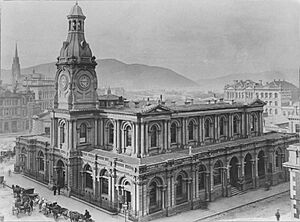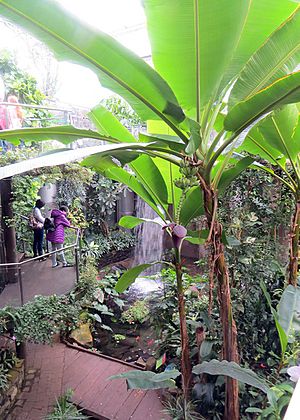Tūhura Otago Museum facts for kids
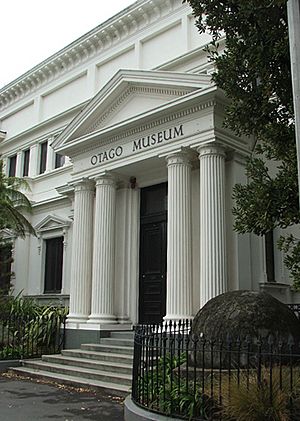
Otago Museum original entrance, with its signature Moeraki boulder
|
|
| Established | 1868 |
|---|---|
| Location | Dunedin, New Zealand |
| Type | Public museum |
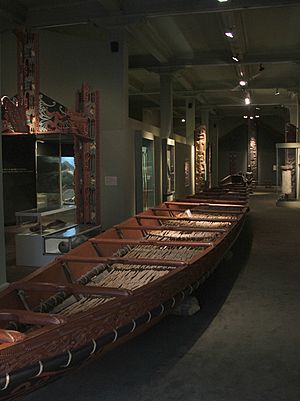
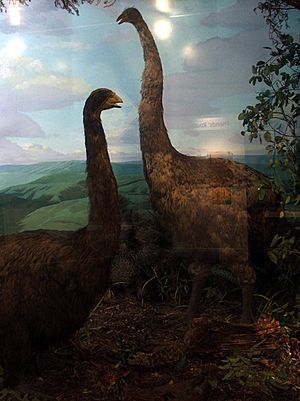
The Tūhura Otago Museum is a big and exciting museum in Dunedin, New Zealand. It's right next to the University of Otago. This museum is one of the largest in New Zealand and a popular place to visit in Dunedin.
The museum has many collections, from natural science to human history. You can see amazing things from the Otago region and all over the world. A special part of the museum is its interactive science center. It even has a tropical rainforest with live butterflies! In 2022, the museum got its new name, Tūhura Otago Museum. "Tūhura" is a Māori word that means "to discover, investigate, and explore."
Contents
Discovering the Museum's Past
How the Museum Began
The idea for the "Otago Museum" started with James Hector. He used the name for his rock collections shown at an exhibition in Dunedin in 1865. Some of these collections became the very first items of the Otago Museum. The museum first opened its doors to the public on September 12, 1868.
It was first located in the Dunedin Exchange building on Princes Street. Soon, the collections grew too big for the space. A new, bigger building was needed. The foundation for the current building on Great King Street was laid in December 1874. The new building opened in August 1877 and is still part of the museum today. You can still see the original entrance with its grand pillars on Great King Street.
In 1877, the University of Otago started managing the museum. This continued until 1955. Then, a new group called the Otago Museum Trust Board took over.
Growing and Changing Over Time
The museum building on Great King Street is over 100 years old. It is considered a very important historic place.
The first big addition was the Hocken Wing, which opened in 1910. It held Dr. Thomas Hocken's collection of old writings. This collection is now part of the Hocken Collections. Another new part, named after a generous helper named Willi Fels, opened in 1930. Today, this wing holds the People of the World and Tangata Whenua galleries.
In 1963, the Centennial Wing was added for more display space. With all these additions, the museum became much larger. It had many connected parts, which made it a bit confusing to navigate.
In the 1990s and 2000s, the museum went through a big redesign. Architect Ted McCoy created a stunning central Atrium that connected all the different wings. This made the museum much easier to explore. The areas where collections are stored were also improved. They now have special shelving and climate control to protect the items.
A major part of this redesign was the Southern Land, Southern People gallery. It opened in 2002. Famous explorer Sir Edmund Hillary helped open it.
The Science Center and Tropical Forest
The museum's interactive science center, Discovery World, first opened in 1991. During the big redesign, it moved to the first floor. In 2007, a huge new part was added to the science center: the Tropical Forest. This is an amazing indoor rainforest where you can see live butterflies and other tropical plants and animals. The Tropical Forest has become a very popular attraction on its own.
A planetarium was added to the science center in 2015. In 2017, Discovery World was updated again. It reopened as the 'Tūhura Otago Community Trust Science Centre'.
In 2013, an old bluestone building on the Museum Reserve was reopened. It's now called the H. D. Skinner Annex. This building, which used to be a post office, is used for exhibitions and other museum events.

Generous Supporters
The Otago Museum has one of the most important collections in New Zealand. This is thanks to many generous people and smart ways of getting new items.
Many key supporters were from the same important family in Dunedin. Willi Fels, a businessman from Germany, had a very long and helpful relationship with the museum. He gave many items himself. He also set up a fund to buy new things and encouraged others to donate valuable items. He even helped raise money to build the wing named after him.
Amazing Collections at the Museum
The museum has two main types of collections: natural science and human history.
Natural Science Wonders
The natural science collection includes insects and other specimens that are important worldwide. The spider collections have spiders from the Pacific area and many other parts of the world. There are over 40,000 marine invertebrate specimens (animals without backbones that live in the sea). The museum also has 30,000 bird specimens, including nests and eggs.
The moa collection is one of the best in the world. The museum has two of the three complete moa eggs known to exist globally: the Ettrick Egg and the First Earnscleugh Egg.
Human History and Culture
The human history side of the museum has strong collections of everyday items and art from Micronesia, Melanesia, Polynesia, and Australia. It also has a large collection of Māori taonga (treasures or artifacts).
From other parts of the world, the museum has many interesting items. These include old weapons and armor from India, ancient coins, Islamic pottery, and Ashanti goldweights. The museum also has about 150 cuneiform tablets and writings. This is the largest collection of its kind in the Southern Hemisphere. You can also find collections of pottery, jewelry, costumes, glassware, clocks, furniture, stamps, guns, cameras, and stone tools.
Museum Leadership Over the Years
Many talented people have led the Otago Museum.
- Frederick Hutton was the curator from 1873 to 1879. He helped design the original building and started building a big natural history collection.
- His successor, Thomas Jeffery Parker, was a brilliant researcher. From 1880 to 1897, he organized the natural history items. He also put together many of the animal skeletons you can still see today.
- Sir William Blaxland Benham was a world-famous scientist. He was curator for 39 years, starting in 1898. He was recognized for his contributions to science and education.
- The first New Zealander to lead the museum was Henry Devenish Skinner, starting in 1937. He was a pioneer in studying human cultures in New Zealand. He greatly expanded the human history collection.
- In 1957, Raymond Robert Forster became director. He focused on scientific research, especially in biology. He became a world expert on spiders and built a huge spider collection.
- Richard Cassels became director in 1987. He started focusing the museum on serving the wider community. During his time, the museum decided to create a science center.
- Shimrath Paul became director in 1995. He had helped set up the interactive science center. He led a big redesign that made the museum a lively place for the community and a world-class attraction. Under his leadership, the Tropical Forest was also completed in 2007.
- Dr. Ian Griffin is the museum's current director, appointed in May 2013. He has a PhD in astronomy and has even discovered 27 asteroids! He brings a strong science background to the museum.
Exploring the Galleries and Exhibitions
Permanent Galleries to Explore
The Otago Museum has seven main galleries that are always there for you to visit:
- Southern Land, Southern People: Learn about the geology and natural history of Otago. See how people in the south used natural resources. A huge plesiosaur fossil, one of New Zealand's largest, is a highlight.
- Tangata Whenua: Discover Māori taonga (treasures), focusing on the Māori people of the South Island.
- The Nature Gallery: Explore natural science stories and specimens from Otago. This includes an old moa diorama.
- Animal Attic: Step into a Victorian-style animal gallery with nearly 3,000 historical animal specimens. See the famous Lawrence lions, which escaped from a circus in 1978!
- People of the World: See human artifacts from all over the globe, including an ancient Egyptian mummy.
- Pacific Cultures: Look at masks, tools, weapons, and more from the islands and cultures of Polynesia and Melanesia.
- The Maritime Gallery: Learn about the sea history of Otago and New Zealand. It has over 50 model ships and a historic fin whale skeleton.
Besides these galleries, there's also:
- Tūhura Otago Community Trust Science Centre: This is the museum's interactive science center. It has two main parts. One part lets you explore science (especially physics and technology) with hands-on exhibits. The second part is the amazing Tropical Forest. It's a three-level rainforest with a six-meter waterfall. You can see hundreds of live, colorful butterflies and other tropical plants and animals.
Special Exhibitions
The museum has a large Special Exhibitions Gallery on Level 1. This is where temporary exhibitions are shown. These exhibitions cover many different topics. Some are created by the museum itself, while others travel from other parts of New Zealand or the world.
The museum works with international museums to bring amazing exhibitions to Otago. For example, the Shanghai Museum sent The Emperor’s Dragons to Otago Museum in 2008. This exhibition showed ancient items with dragon designs that had never been seen outside China before. In return, Otago Museum sent Te Ao Māori: Māori Treasures from the Otago Museum, New Zealand to Shanghai in 2011. This was the first time Māori artifacts were shown in a Chinese museum. Over 600,000 people visited Te Ao Māori!
Learning and Fun for Everyone
School Programs and Education
Thousands of students visit the Otago Museum every year. They take part in programs that connect to what they are learning in school. The museum also offers a popular 'sleepover' program for school groups. A portable planetarium called 'Starlab' can bring astronomy experiences to the museum or to schools in the region.
Community Events
The Otago Museum also organizes many community programs and events. These often go along with the exhibitions and galleries. Many of these events are free! They include family fun days, workshops, guest speakers, movie screenings, activities for children, and daily talks in the galleries. You can find out about upcoming programs on the museum's website.
Awards and Recognition
The Tūhura Otago Museum has won many awards for being a great place to visit:
- Qualmark Endorsed Visitor Activity
- Qualmark Gold status
- Winner of six New Zealand Tourism Awards, including Best Visitor Attraction and Activity in NZ
- Winner of five Westpac/Otago Chamber of Commerce Business Excellence Awards, including the Supreme Business Award in 2004
Notable People Connected to the Museum
- Lily Daff (1885–1945), an artist who was in charge of exhibitions.
- Harry Skinner (1886–1978), an expert in human cultures and a museum director.
- Lyn Forster (1925–2009) and Ray Forster (1922–2000), who were experts on spiders.
Images for kids


